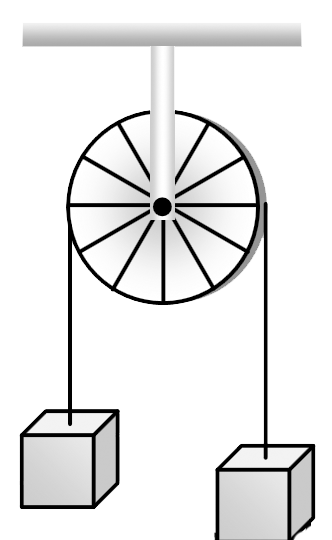A mass of 2kg is suspended with thread AB (figure) Thread CD of the same type is attached to the other end of 2kg mass. Lower thread is pulled gradually, harder and harder in the downward gradually, harder and harder in the downward direction so as to apply force on AB. which of the threads will break and why?

The thread AB will break earlier than the thread CD. This is because force acting on thread CD = applied force and force acting on thread AB = (applied force + weight of 2 kg mass). Hence, force acting on thread AB is larger than the force on thread CD.
Similar Questions
A mass of 2kg is suspended with thread AB (figure) Thread CD of the same type is attached to the other end of 2kg mass. Lower thread is pulled gradually, harder and harder in the downward gradually, harder and harder in the downward direction so as to apply force on AB. which of the threads will break and why?

View SolutionA shell of mass 1kg is projected with velocity 20m/s at an angle 60∘ with horizontal. It collides inelastically with a ball of mass 1kg which is suspended through a thread of length 1m. The other end of the thread is attached to the ceiling of a trolley of mass 43kg as shown in figure. Initially the trolley is stationary and it is free to move along horizontal rails wihtout any friction. What is the maximum deflection of the thread with vertical? String does not slack. Take g=10m/s2.

View Solution
Knowledge Check
Two masses of 10kg and 5kg are suspended from a rigid support as shown in figure. The system is pulled down with a force of 150N attached to the lower mass. The string attached to the support breaks and the system accelerates downwards

In case the force continues to act. what will be the tension acting between the two masses ? .A20m/s2B10m/s2C5m/s2DzeroTwo masses of 10 kg and 5 kg are suspended from a rigid support as shown in figure. The system is pulled down with a force of 150 N attached to the lower mass. The string attached to the support breaks and the system accelerates downwards.

In case the force continues to act. what will be the tension acting between the two masses ?A300 NB200 NC100 NDzeroA light string passes over a frictionless pulley. To one of its ends a mass of 6 kg is attached. To its other end a mass of 10 kg is attached. The tension in the thread will be
 A24.5 NB2.45 NC79 ND73.5 N
A24.5 NB2.45 NC79 ND73.5 N
A vertical spring supports a block in equilibrium. The spring is designed to break when extension in it crosses a limit. There is a light thread attached to the block as shown. The thread is pulled down with a force F which gradually increases from zero. The spring breaks when the force becomes F0. Instead of gradually increasing the force, if the thread were pulled by applying a constant force, for what minimum value of the constant force the spring will break?

View SolutionTwo masses of 5 kg and 10 kg are suspended from a fixed support as shown in the figure. The system is pulled downwards with a force of 150 N applied to the lower mass. The string attached to the support breaks and the system accelerates downwards. If the downward force continues to act, the acceleration of the center of mass of the system is :

View SolutionA mass of 1 kg is suspended by means of a thread. The system is (i) lifted up with an acceleration of 4.9ms−2 (ii) lowered with an acceleration of 4.9 ms−2. The ratio of tension in the first and second case is
View SolutionA mass of 1 kg is suspended by means of a thread. The system is (i) lifted up with an acceleration of 4.9ms−2 (ii) lowered with an acceleration of 4.9ms−2. The ratio of tension in the first and second case is
View SolutionA mass of 1 kg is suspended by means of a thread. The system is (i) lifted up with an acceleration of 4.9ms−2 (ii) lowered with an acceleration of 4.9ms−2. The ratio of tension in the first and second case is
View Solution
